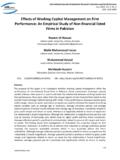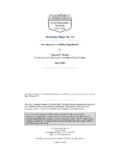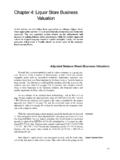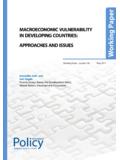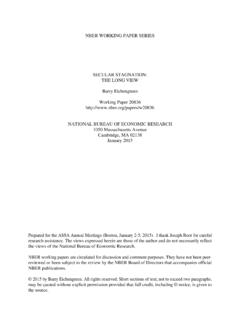Transcription of Working Capital Adjustments in M&A Transactions
1 Working Capital Adjustments in M&A TransactionsNavigating a MinefieldBrian B. GilbertG&R ReviewM&A Transactions typically include a true-up for Working Capital as a component ofthe economic consideration. Buyers want to insure that they are acquiring abusiness on a going-concern basis that will be stocked with sufficient Working capitalto meet the immediate needs of the business, including obligations to customers andtrade creditors. Sellers want to be compensated for earnings and profits theygenerate and for assets of the business that their efforts created. These seemingly simple and straightforward desires can lead to complicatedprovisions that can end up in dispute in the implementation if not carefully drafted. This article will explorethe various issues in drafting Working Capital adjustment provisions and potential problem 1 - Components of Working Capital and Valuation Principles Under Generally Accepted Accounting Principles ("GAAP"), the concept of " Working Capital " is simply the sumof current assets over current liabilities.
2 However, in the context of M&A Transactions , rarely is workingcapital defined in such a simplistic manner. Current asset components include cash, inventory, accountsreceivable, and prepaid items. Current liabilities include accounts payable and accrued expenses. We willexplore each of these items Many deals are priced on a cash free/debt free basis. As such cash and cash equivalents are normally notincluded in the calculation of Working Capital . Nevertheless, depending on the nature of the business, Buyersmay want to ensure that they will have enough operating cash on hand as of closing. This can beaccomplished either by (a) requiring Sellers to leave a certain level of petty cash in the business for whichthey will receive credit in the Working Capital adjustment , or (b) Buyer immediately funding in cash on itsown at closing such that the business can continue to operate.
3 Normally (a) is the recommended approachas it is more seamless to the operation of the Inventory and accounts receivable are generally the largest components of current assets included in thecalculation of Working Capital and each pose unique issues in their calculation. With respect to inventory, onecalculation of Working Capital and each pose unique issues in their calculation. With respect to inventory, oneof the key questions is whether the parties will agree to conduct an inventory at the time of closing todetermine actual inventory on hand. If inventory is determined based on a perpetual system, it may bepossible to roll the inventory forward from the last physical count. Buyer will need to diligence the accuracyof Seller's perpetual system and be comfortable with roll forward procedures in order to accept physical inventory can sometimes be disruptive and impractical depending on the nature of the business.
4 From a Buyer's perspective, without a perpetual system or roll forward procedures, not taking a physicalinventory at closing creates risks that may not be able to be fleshed out through due diligence or apost-closing process. In this case, Buyers would in effect be relying on the recordkeeping prowess of theSeller and may have little recourse to challenge Seller's determination. A Buyer taking an inventory on itsown days or weeks after closing and then using that inventory to challenge the closing figures will lead toinevitable disputes between Buyers and Sellers over the post-closing activities, the valuation, and inventorytaking is another key issue in determining the inventory component. Whether inventory is determined onFIFO or LIFO, lower of cost or market and what will constitute slow-moving, obsolete or damaged inventoryare all issues that should be specifically dealt with in the definitive documentation.
5 Normally valuationmethodologies can be set forth on a schedule to the purchase agreement. Failing to specifically definevaluation methodologies is a recipe for future , it is important to determine whether any Adjustments are necessitated as a result of the nature andhistory of the Seller's inventory system. Normally a LIFO system reflects a more accurate picture ofearnings and profits especially in an environment with ever increasing costs. The LIFO reserve accountreflects the difference between the LIFO cost and FIFO cost of a Seller's inventory since the date that LIFOwas adopted by the Seller. In an inflationary environment, this is normally a contra-inventory account andtherefore reduces the value of inventory. Correspondingly, this will also increase the cost of goods sold andtherefore reduce earnings and profits.
6 It is therefore important to agree upon the affect of the LIFO reservenot only in the calculation of Working Capital but also vis- -vis the valuation of the business as a Receivable Similar to inventory, determining the valuation methodology for accounts receivable is crucial to avoidingfuture disputes. Normally a business will carry a reserve for doubtful accounts (which should reduce theamount of accounts receivable included in Working Capital ); however, the methodologies for includingaccounts in the reserve can differ widely. Buyers need to understand historical methodologies employed bySeller for compiling its accounts receivable reserve. The principles used in determining the accountsreceivable reserve in calculating net Working Capital should be clearly set forth in the purchase agreement.
7 In certain Transactions , it may be feasible to agree on a formulaic approach up-front so as to avoid anypost-closing or calculation disputes. Such a formula would assign a certain percentage credit to the workingcapital depending on the aging schedule for the receivables. For example, all receivables less than 30 daysold would receive 90% credit in Working Capital , 30-60 day receivables would be credited 75%, 60-90 dayreceivables 50% and over 90 days no credit. While a formula such as this brings certainty in connectionwith the net Working Capital calculation, it may or may not provide the Seller with adequate credit for itsreceivables depending on how the formula is more typical approach is to value the outstanding receivables less an appropriate reserve for doubtfulaccounts.
8 Reserves for receivables may be specific or general. A general reserve is established to accountfor the typical experience of the business with respect to un-collectibles. It is important to understand thehistorical methodologies for establishing these reserves so that as business metrics change, the necessarychanges in the reserves can be monitored. For example, if a reserve is established based on a percentage ofrevenue, as revenues increase, the reserve should increase as well. Specific reserves for receivables aregenerally established once an account is known to be in trouble. At that point, the general reserve should beadjusted for such account and a specific dollar reserve set up to track the troubled account. In the event that a formula is not used, the provision regarding Working Capital should deal specifically withthe effect that post-closing collections of receivables will have on the calculation of Working Capital ,particularly collections that occur prior to the time that any post-closing adjustment is finalized.
9 Seller willwant credit for post-closing collections, especially if those receivables were included in the reserve. Depending on the length of time post-closing, Buyer may take the position that the collection was due toBuyer's efforts and, as a result, should not be credited to Seller in Working Capital . From a Buyer'sperspective, the purchase agreement should specifically provide that collections after closing, or a certainspecified date, should be omitted from the net Working Capital calculation. Seller's may prefer to remainsilent on this issue or provide that until Working Capital is finalized post-closing, that it will receive credit forall Payable While inventory and accounts receivable are generally the largest asset components of Working Capital ,accounts payable is the largest liability component.
10 The struggle between Buyers and Sellers with respect toaccounts payable is usually over the fact that Sellers desire to clear their plates of all payables and haveBuyers assume all payables on the books as of Closing. Buyers only want to assume liabilities related to theacquired business and only those liabilities for which they receive credit in the calculation of the which payables to include in the calculation of Working Capital becomes more difficult when aBuyer is not acquiring all businesses of a Seller. When divisions are split off or certain lines of business aresold and others retained, payables may apply to both acquired and retained businesses or one or the other. While cumbersome, the safest route from a legal perspective is to schedule the assumed and includedpayables in a schedule to the purchase agreement together with an allocation methodology.


